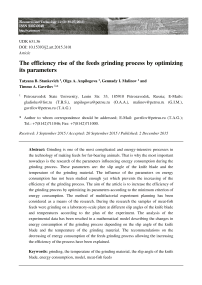The efficiency rise of the feeds grinding process by optimizing its parameters
Автор: Stankevich Tatyana B., Anpilogova Olga А., Malinov Gennady I., Gavrilov Timmo А.
Журнал: Resources and Technology @rt-petrsu
Статья в выпуске: 12 (2), 2015 года.
Бесплатный доступ
Grinding is one of the most complicated and energy-intensive processes in the technology of making feeds for fur-bearing animals. That is why the most important nowadays is the research of the parameters influencing energy consumption during the grinding process. These parameters are: the slip angle of the knife blade and the temperature of the grinding material. The influence of the parameters on energy consumption has not been studied enough yet which prevents the increasing of the efficiency of the grinding process. The aim of the article is to increase the efficiency of the grinding process by optimizing its parameters according to the minimum criterion of energy consumption. The method of multifactorial experiment planning has been considered as a means of the research. During the research the samples of meat-fish feeds were grinding on a laboratory-scale plant at different slip angles of the knife blade and temperatures according to the plan of the experiment. The analysis of the experimental data has been resulted in a mathematical model describing the changes in energy consumption of the grinding process depending on the slip angle of the knife blade and the temperature of the grinding material. The recommendations on the decreasing of energy consumption of the feeds grinding process allowing the increasing the efficiency of the process have been explained.
Grinding, the temperature of the grinding material, the slip angle of the knife blade, energy consumption, model, meat-fish feeds
Короткий адрес: https://sciup.org/147112311
IDR: 147112311 | DOI: 10.15393/j2.art.2015.3101
Список литературы The efficiency rise of the feeds grinding process by optimizing its parameters
- Gavrilov T. A., Nianikova A. V., Patalaynen L. S., Shirokih A. K. 2013. The rise of fur farming efficiency with the development of diet composition methods. Polythematic online scientific journal of Kuban State Agrarian University 91 (7): 1194-1203.
- Malinov G. I., Kondrashov V. F., Gavrilov T. A. 2013. Studying of influence of elastic-viscous material thickness on shredding work. Agrarian Bulletin of the Urals 113 (7): 30-32.
- Vasilyev S. B., Dospehova N. A., Kolesnikov G. N. 2013. Simulation of unequal diameter spruce pulpwood interaction in debarking drum. Resources and Technology 10 (1): 24-38.
- Kolesnikov G. N. 2013. Decomposition algorithm of linear complementarity problem and its application for simulation of pulpwood collisions in debarking drum. Resources and Technology 10 (2): 111-138.
- Karjalainen T., Jutila L., Leinonen T., Gerasimov Y. 2013. The effect of forest policy on the use of forest resources and forest industry investments in Russia. Resources and Technology 10 (2): 90-101.
- Leinonen T., Honkanen A. 2013. CONIFER -Connecting Finnish-Russian Forest Sector Expertise. Resources and Technology 10 (1): 39-43.
- Zhou D., McMurray G. 2011. Slicing cuts on food materials using robotic-controlled razor blade. Modelling and Simulation in Engineering 2011, DOI: Available online: http://www.hindawi.com/journals/mse/2011/469262/cta/(accessed on 19 March 2015) DOI: 10.1155/2011/469262
- McGorry R. W., Dowd P.C., Dempsey P. G. 2005. The effect of blade finish and blade edge angle on forces used in meat cutting operations. Applied Ergonomics 36 (1): 71-77.
- McGorry R. W., Dowd P.C., Dempsey P. G. 2005. A technique for field measurement of knife sharpness. Applied Ergonomics 36 (5): 635-640.
- Claudon L., Marsot J. 2006. Effect of knife sharpness on upper limb biomechanical stresses -a laboratory study. International Journal of Industrial Ergonomics 36 (3): 239-246.
- Marsot J., Claudon L., Jacqmin M. 2007. Assessment of knife sharpness by means of a cutting force measuring system. Applied Ergonomics 38 (1): 83-89.
- Kwon Y.-D., Park S.-J., Choi W.-G., Bang S.-I., Kwon H.-W. 2014. Shear cutting theory for the peripheral edges of brush blades, and tests of its effectiveness. International Journal of Precision Engineering and Manufacturing 15 (7): 1459-1465.
- Tong B.-H., Sun J., Xu Z.-H., Chen Z.-Y., Ji B., Song B. 2013. Experimental study and comprehensive evaluation on meat grinding. Modern Food Science and Technology 29 (12): 2953-2957.
- Spinellia R., Glushkovb S., Markov I. 2014. Managing chipper knife wear to increase chip quality and reduce chipping cost. Biomass and Bioenergy 62: 117-122.
- Kováč J., Krilek J. 2011. The possibilities for measurement of saw blades wearing. Acta Universitatis Agriculturae et Silviculturae Mendelianae Brunensis 59 (5): 137-144.


